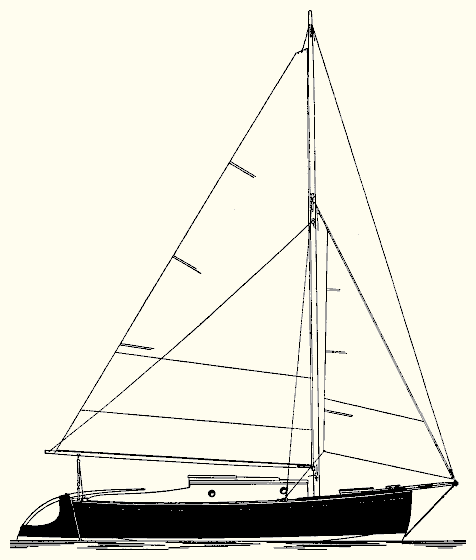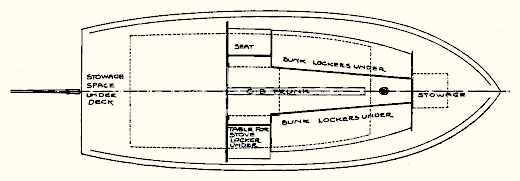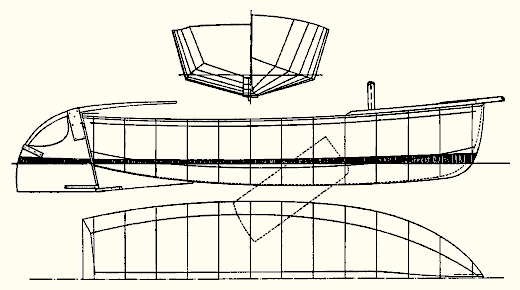
| Wild Oats An 18' V-Bottom cruising Sloop By William Atkin |
| Skipjack Sister to Red Onion | |
| Continually since the appearance of the design for Red Onion in the July issue of MoToR BoatinG many (meaning a perfect raft) letters have come to hand requesting designs for a boat of equal dimensions and capacity. This one, however, was to be of V-bottom underbody, or to designate the form correctly, skipjack model. And so, here she is, Wild Oats, the name, by the way, being borrowed from an old time work boat of skipjack model of an older generation. | |

| |
The dimensions of Wild Oats are: overall length, 18 feet, 0 inches; water line length, 17 feet, 0 inches; breadth, 7 feet; draft, 1 foot, 3 inches; freeboard bow, 2 feet, 9 inches; freeboard stern, 2 feet, 2 inches. Quite a chunk of a boat and equal to going places in rough water. Above the water line, excepting the curve of the stem and the jib head rig, the form of Wild Oats is identical to Red Onion. Therefore the rigs of the two designs are interchangeable. The difference in the centers of effort of the two sail plans is so little as to be negligible, a matter of only a few inches. The sail area of Wild Oats is 200 square feet For my own use I would use a gaff head rig as shown for Red Onion. After many years of observation and experiment I feel the shorter mast of the gaff rig, the ability to adjust the set of the sail by simply slacking or hauling the peak and throat halyards, and the elimination of sail slides and track more than offset the doubtful (in my mind) advantage of the tall narrow sail plan of the jib-headed rig. To be sure the latter is more in the mode, more stylish, and theoretically more efficient. But I am given to wonder, "Is it?" | |

| |
| The cabin is very simple in layout: two bunks, table for small stove, seat, and lockers. There is 4 feet headroom under the sliding hatch; 3 feet, 8 inches under the cabin top beams. Not much from the standpoint of a 30-foot cabin motor boat; but welcome enough in a little hooker like Wild Oats. If the headroom is increased the boat will be spoiled from the standpoint of appearance, and ability. Plenty high as drawn now. I should not change it. | |

| |
The lines show a straight sectioned V model, the chine lines dropping below the water line between stations 3 and 9. The keel is an easy sweep finishing aft slightly below the water line; the lower part of the stern transom being slightly submerged. The center board is large, as is the rudder. These features assure the boat's ability to sail on the wind and come about with certainty against any head sea. There are far too many otherwise excellent small sailing boats with center boards, and especially rudders, that are scanty in area. The deck line is full, a feature that permits wholesome flare to the topsides above the line of the chines. It's more difficult to build this way but well worth the extra work. The boat will be dryer for the flare, have better stability, more room on deck, and be in better balance when heeled down. The skipjack model will be somewhat more difficult to build but the materials required will be nearly the same. For amateur boat builders the V, or skipjack, model seems most popular; however it is not an especially easy boat for a professional builder to put together. The corners of the chines are always bothersome, requiring a lot of time to make them run in perfectly fair lines looking from both bottom and sides. Most regularly equipped boat builders favor round bilge boats, but few amateur builders are equipped with steam box, bending battens, etc. Therefore the diamond sectioned model, or the simple flat bottomed hull are the logical types for the amateur builder. | |
 PHOTOS OF WILD OATS PHOTOS OF WILD OATS 
| |
| Plans for Wild Oats are $100 MYSTIC SEAPORT MUSEUM SHIPS PLANS STORE https://store.mysticseaport.org/ships-plans/ shipsplanstore@mysticseaport.org
+1 (860) 572 5360 | |
| BACK TO PLAN LIST | |